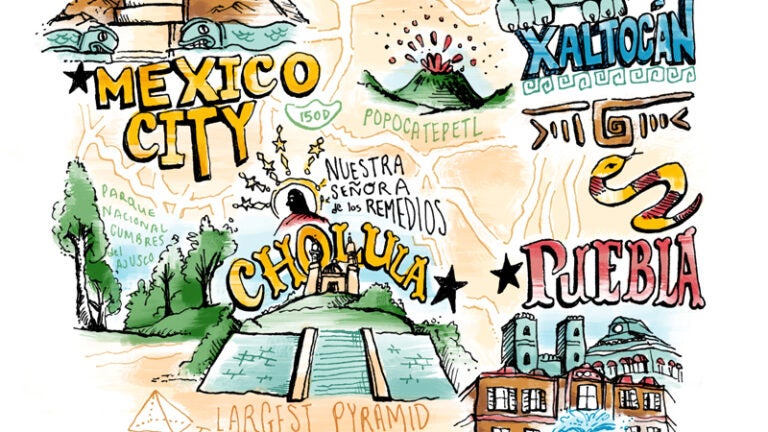
(Illustration/Russell Shaw)
In Mexico, USC Students Find Connections to Cities Lost to Time
Each summer, USC archaeology students follow in the footsteps of history.
Kirby Farah loves Mexico — especially its rich history. A lecturer in anthropology at the USC Dornsife College of Letters, Arts and Sciences, Farah first visited the country more than a decade ago as a graduate student. Now she shares her passion with USC undergrads. Each summer, she takes a group to explore Mexico’s culture and centuries-old artifacts through a USC archaeology program.
This year, students Maria Camasmie, Lilah Mehri and Katya Pérez made the journey. The trio perched atop the massive Pyramid of the Sun and stared out across the ancient city of Teotihuacán. Gazing at the remnants of intricate temples and underground passages, they understood why the Aztecs who rediscovered the abandoned city called it “the birthplace of the gods.”
“I tried to imagine what the site would have looked like 2,000 years ago, with people bustling along the Avenue of the Dead, and fires lighting up homes,” Pérez says. “Being in the rain and looking at the clouds surrounding the landscape felt ethereal and spiritual.”
I tried to imagine what the site would have looked like 2,000 years ago, with people bustling along the Avenue of the Dead, and fires lighting up homes.
Katya Pérez
It was one of many unforgettable moments from the USC students’ whirlwind two-week trip across central Mexico in June. Below, follow along on their travels from Mexico City to Puebla, Cholula and beyond.
MEXICO CITY
Once an Aztec capital, Mexico City was razed and rebuilt by the Spanish in the 16th century. USC students had a taste of its former glory at Templo Mayor, the remains of the Aztecs’ main temple. “It was this little square of ruins surrounded by all these newer buildings,” Pérez says. “But you could picture what the whole city once looked like.” They visited another notable site, as well: el Museo Nacional de Antropología, Mexico’s largest museum.
XALTOCÁN
This small village dates to 1000 A.D. Builders raised it on a man-made island in a now-dry lake of the same name. Farah helped Camasmie, Mehri and Pérez interview lifelong residents about their heritage and how archaeological studies in the area affect them.
PUEBLA AND CHOLULA
The world’s largest known pyramid by volume stands in Cholula, a city established in about 500 B.C. USC students learned about the city’s original inhabitants, who remained independent from the Aztec empire. Students also visited nearby Puebla. The Spanish colonial town’s claim to fame? It’s the home of Cinco de Mayo, which celebrates the Mexican army’s 1862 victory over French forces.
TEOTIHUACÁN
This famed archaeological site in Mexico served as one of the most important cities in the pre-Hispanic Americas. It reached its heyday by 600 A.D. Relics with its iconography have been found as far away as present-day Guatemala and the Yucatán. No one knows the site’s original name; when the Aztecs came across it, the city had long been deserted.
Mexico is one of several destinations students visit through USC’s archaeology program. Learn more about students’ experiences through their photo blog.



